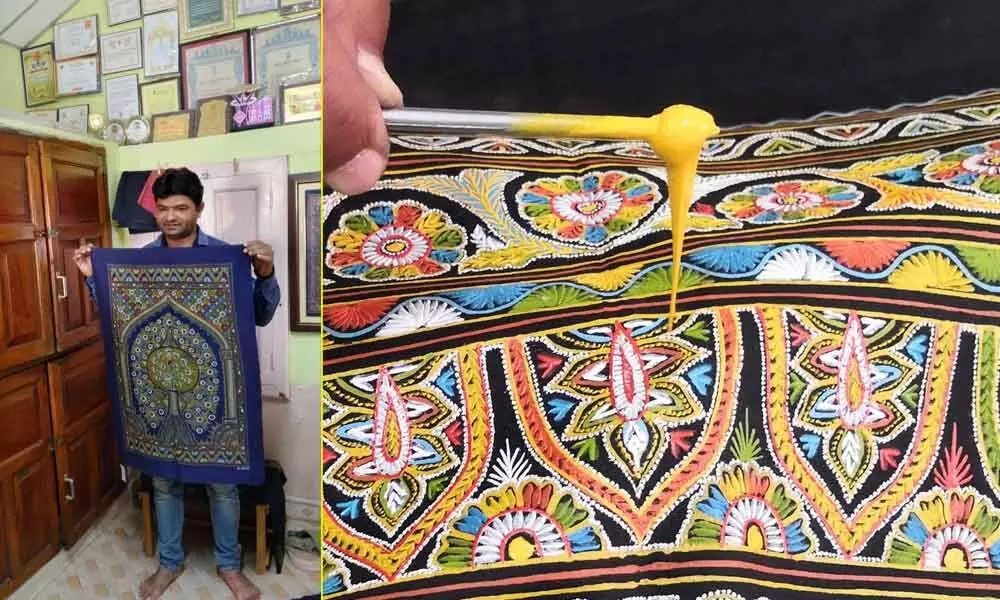Live
- Rural students' options shrink as US colleges slash majors: Report
- Samsung announces new leadership to stay relevant in chip biz
- Telangana: 8 Bikes Destroyed in Massive Fire Accident in Hyderabad
- Death toll rises to 29 in Tanzania's building collapse
- Gold rates in Visakhapatnam today surges, check the rates on 27 November, 2024
- Childbirths in South Korea rises by largest margin in 14 years in September
- NZ's Nathan Smith to debut in 1st Test vs England; Young makes way for Williamson, confirms Latham
- Champions League: Feyenoord stun Man City, Inter go on top; Arsenal thrash Sporting
- Study finds potential genes linking depression to menstrual pain
- Indian stock market opens flat, all Adani shares trade in green
Just In

Rogan, a traditional art
A delicate art requiring much skill and patience, rogan painting is the pride of Gujarat. This art is practised in the Kutch district of Gujarat
Walking through the small bylanes of the village Nirona, in this area of Gujarat, we arrived at the home of Abdul Gafur Khatri, the patriarch of the family of experts considered the best and most authentic practitioners of this art. This art involves usage of paint made from vegetable dyes and boiled oil (castor) which is laid down in delicate lines on fabric. A stylus if often used for this. It requires much creativity, great attention to detail and patient, painstaking efforts. One hand is used to draw the design and the other hand's fingers are placed under the fabric to help shape its final appearance and form. All this was demonstrated for us by members of Ghafur's family.
Whether it was in exhibitions outside Gujarat, in documentaries on this art, or the few emporiums which retail these items, and in this home itself, we enoticed that all the paintings were done on cloth of dark colours like rich yellow, ink-blue, red, green, etc. When asked for the reason, the artists replied: "The fine lines we draw and motifs stand out when done on a dark background, hence the choice of these hues." There were piles of this rogan paintings in their home. The Tree of Like painting is very popular with customers. It requires intricate detailing.
The art which is being practised from around four centuries in India, is believed to have origins in Iran. In fact, the world rogan itself comes from the Persian word for oil or varnish. However, there are no authentic records which trace this entire history.
At first, several families in Kutch practised this art. It was a seasonal art. However, as with so many ancient arts and crafts of India, which are handmade, with the advent of machine-made textiles and other such products, this art lost many buyers as it was seen as relatively more expensive and hence not so affordable. Over the years, just one family, that of Abdul Ghafur, kept this tradition going.
However, today, this intricate and beautiful art has seen a revival.
A few events helped in a big way in the resurgence of this art. The first had an unfortunate cause. The 2001 earthquake in this region which devastated the area also led to major relief efforts by the government. Even as roads were rebuilt and electricity and water connections restored, attention was also paid to reviving the tourism attractions of the region by giving better connectivity and publicity to the artistic heritage in order to give an economic boost. The work of artisans from the area was sent and retailed in urban outlets within and outside the state. Thus rogan painting too benefitted. When the Prime Minister Narendra Modi, in 2014, gifted rogan paintings made by Abdul Gafur to USA President Barrack Obama, it generated tremendous publicity for the art. Finally, the awards given to members of the Khatri family at the state and national level increase respect for the art and the family and helped sales.
Today, the patriarch of the family and his members have trained many young women in the art. "This is our way of keeping the art alive and thriving and also contributing to the cause of women's empowerment," says Abdul Gafur.
The other Khatri family members say: "We are happy that the tourist footfall and hence our business has increased as a result of the above causes." However, the pandemic has impacted them as it has the rest of the world and they say they are waiting for better times, when more people will be able to travel and visit them to see this exquisite art in demonstrations and take home a piece of the same. Indeed, they will be soueviners of the great artistic traditions of Gujarat.

© 2024 Hyderabad Media House Limited/The Hans India. All rights reserved. Powered by hocalwire.com







